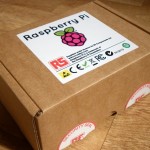 Yes, I was one of those geeks who got up at 6am to order a Raspberry Pi. It has been a long wait since then but I now have my Pi to play with. This is a quick blog post to summarises what I have learnt from it in my day of playing.
Yes, I was one of those geeks who got up at 6am to order a Raspberry Pi. It has been a long wait since then but I now have my Pi to play with. This is a quick blog post to summarises what I have learnt from it in my day of playing.
Despite completing the RS form in the first minute and getting an order in on the Farnell site (in between it falling over) I was not quick enough in the first batch, but out of the blue I got an email from RS saying that I could now order one, and that I did, and it arrived yesterday. :-)
It is important to remember that the Raspberry Pi is at the moment just a development board that requires quite a few bits and bobs to get up and running. Fortunately I managed to scavenge…
- Power supply with a micro USB connector (Normally used for myy Mifi)
- A fast SD card (Spare card for my digital camera)
- HDMI to VGA converter (Purchased from http://amzn.to/Lp2MGG for £15)
- USB Keyboard and Mouse
- Network cable and access point set up as client
Yes, I don’t have a TV or monitor with an HDMI input but the converter works well, and using the wifi access point as a client means I don’t need to run a cable through the house.
I downloaded the recommended Debian “squeeze” image listed on the Raspberry Pi web site using BitTorrent on my Windows machine. Creating the SD card was easy although it took an age to work out what was an advert and what was the download link for Win32DiskImager. Writing the image was easy but the the image was for a 2GB card and I was using a 4GB one. It worked fine but I was wasting half the card. In the end I needed to use a Linux machine to resize the partition to use all the card.
The Pi running squeeze boots quickly enough. Officially you can not run YouTube on the Pi yet but you can install Google’s Chrome (just type “sudo apt-get install chromium-browser” in to the command line) and that will allow flash and HTML5 videos to [just about] play. It manages a frame rate of around half a frame a second at best. The Broadcom chip set is capable of playing accelerated video but there is a little work to be done yet.
I have not been able to get the sound working yet but this could be because the sound is being sent to the HDMI port instead of the 35mm jack socket. I will have to look further in to this.
So that is as far as I have got. To summarise the Raspberry Pi is a lovely little computer. I don’t feel it is in a position for people to start really learning on until the operating system matures. In fact it is currently more complex than the average home computer, but we should remember that this is currently a development board and not pretending to be ready for the classroom yet.
Following several comments online I also note is that there are plenty of other board around and the Pi is not built of bleeding edge technology any more, but that is not the point. It’s success will be built on it’s community, and the media hype and low cost can only help broaden this community and make the Pi a success. It is not really challenging the Arduino as it is not comparable, and it is not going to take much business from other boards as it is creating a new market and not competing in the same market.
There is one thing that does worry me though. One key advantages of the BBC B microcomputer, that the Pi is frequently being compared to, is that you could programme it out of the box following a few simple instructions. This is not the case with the Raspberry Pi yet. This is not to say that this will not come, but at the moment you need to go out of your way to programme something and it appears we are relying on the community to rectify this. Much of the community seem more keen to make it do cool things instead of make it easy to programme and we can’t blame anyone for that.
Finally, like many, I ordered from both RS and Farnell and have already paid Farnell for one. Because of demand we are only supposed to have one Pi and I am planning honour this by selling the second one locally at cost to someone deserving. If that could be you let me know, but I am not expecting in until the end of June.
 Delicious
Delicious Flickr
Flickr Google Plus
Google Plus Hackaday
Hackaday Instructables
Instructables Lanyrd
Lanyrd Twitter
Twitter YouTube
YouTube Facebook
Facebook Geocaching
Geocaching
In fact it is currently more complex than the average home computer,
that is because “average home computer” now has its details hidden, and raspberry pi just shows these details, which is essential if you want to become a real programmer, I think.